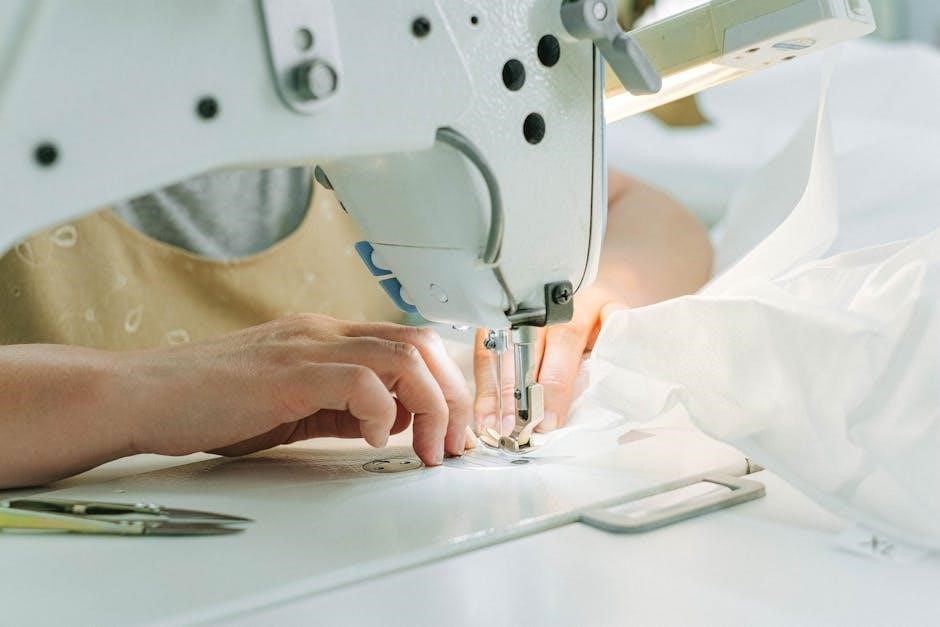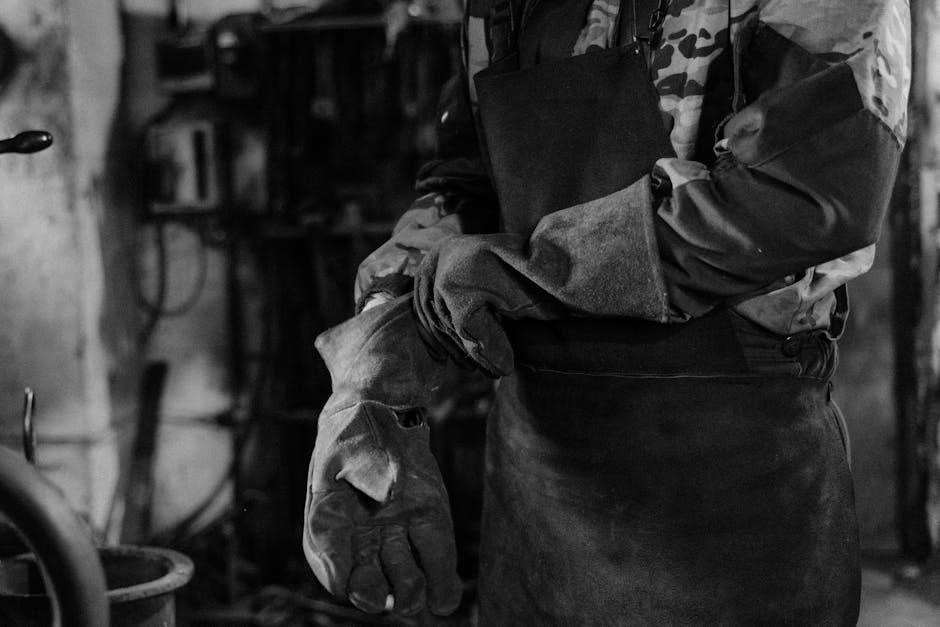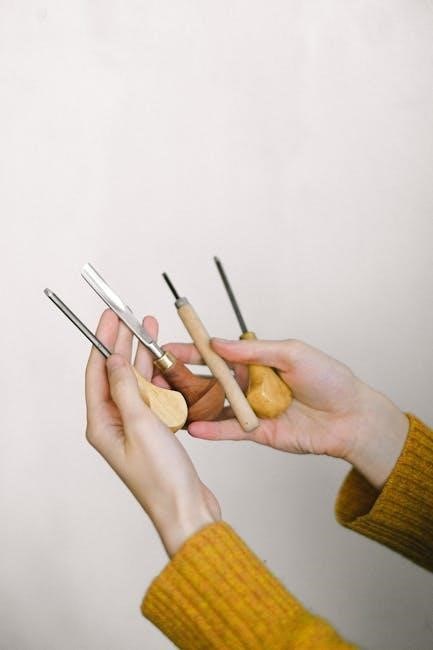Manual skills encompass practical abilities requiring hand-eye coordination and dexterity, essential for craftsmanship, art, and technical tasks. Historically, these skills were vital for survival and innovation, evolving over time to adapt to modern tools and technologies while maintaining their core value in creativity and functionality.
1.1 Definition and Scope
Manual skills refer to the physical and cognitive abilities necessary to perform tasks that require precision, dexterity, and coordination. These skills are fundamental for activities such as craftsmanship, artistry, and technical work, emphasizing the use of hands and tools. The scope of manual skills is broad, encompassing both practical and creative applications. They are essential in trades like carpentry, mechanics, and craftsmanship, where physical execution is key. Additionally, manual skills play a role in artistic expression, such as painting, sculpting, or playing musical instruments. The development of these skills often requires practice, patience, and dedication, as they rely on muscle memory and hand-eye coordination. In a world increasingly reliant on automation, manual skills remain vital for preserving traditional knowledge and fostering innovation. They also contribute to personal satisfaction and problem-solving abilities, making them indispensable in various aspects of life.
1.2 Historical Context
Manual skills have deep roots in human history, dating back to ancient times when tool-making and craftsmanship were essential for survival. Early humans developed dexterity to create weapons, shelter, and art, laying the foundation for manual proficiency. As civilizations evolved, so did the complexity of these skills, with advancements in metallurgy, agriculture, and construction. The Middle Ages saw the rise of guilds, where apprentices honed their manual skills in trades like blacksmithing, carpentry, and weaving. These skills were not only practical but also integral to cultural and artistic expression. The Renaissance period further elevated manual skills, as artisans and inventors like Leonardo da Vinci pushed the boundaries of creativity and innovation. The Industrial Revolution brought mechanization, shifting focus from individual craftsmanship to mass production, yet manual skills remained crucial for maintaining and improving machinery. Today, despite technological advancements, manual skills continue to be celebrated for their ability to preserve tradition, foster creativity, and solve practical problems. Their historical significance underscores their enduring value in both functional and artistic contexts.
1.3 Importance in Modern Society

Manual skills remain highly valued in modern society, offering a unique combination of practicality, creativity, and personal fulfillment. In an increasingly technology-driven world, these skills provide a counterbalance by fostering hands-on problem-solving and innovation. They are essential in various industries, from healthcare and engineering to art and craftsmanship, where precision and dexterity are critical. Additionally, manual skills play a significant role in education, as they enhance cognitive development and encourage interdisciplinary learning. The ability to create or repair items manually also promotes sustainability by reducing waste and extending the life of products. Furthermore, manual skills contribute to mental well-being by offering a therapeutic outlet and a sense of accomplishment. As technology advances, there is a growing appreciation for the human touch that manual skills provide, ensuring their relevance and importance in contemporary life. By nurturing these abilities, individuals and communities can preserve tradition while adapting to modern challenges, making manual skills a timeless and invaluable asset.
1.4 Evolution Over Time
Manual skills have undergone significant evolution, adapting to societal needs and technological advancements. From primitive tool-making to modern precision craftsmanship, these skills have transformed alongside human progress. In ancient times, manual dexterity was crucial for survival, with tasks like hunting and agriculture relying on rudimentary tools. The Industrial Revolution marked a turning point, introducing machinery and standardization, which shifted manual skills toward more specialized trades. In the digital age, automation and AI have redefined the landscape, yet the demand for human expertise in areas like craftsmanship, repair, and creative expression persists. The integration of digital tools, such as 3D printing and laser cutting, has expanded the possibilities for manual skills, blending tradition with innovation. Despite these advancements, the core essence of manual skills—precision, creativity, and problem-solving—remains unchanged. Their evolution reflects humanity’s adaptability, ensuring their continued relevance in a rapidly changing world. By embracing both traditional techniques and modern technologies, manual skills evolve to meet new challenges while preserving their timeless value.

Types of Manual Skills

Manual skills encompass a diverse range of capabilities, including craftsmanship, technical proficiency, practical applications, and creative expression. These categories reflect the adaptability of manual skills, from artistic creation to problem-solving, highlighting their universal relevance in various contexts and industries.
2.1 Craftsmanship and Artistry
Manual skills in craftsmanship and artistry involve the mastery of techniques to create objects of both functional and aesthetic value. These skills often require precision, creativity, and attention to detail, reflecting the artisan’s ability to transform raw materials into meaningful works. Craftsmanship emphasizes the perfection of traditional methods, while artistry focuses on innovation and personal expression. Together, they represent the pinnacle of human creativity and dexterity.
Historically, craftsmanship and artistry were central to cultural development, with artisans creating everything from tools and furniture to decorative items and religious artifacts. Today, these skills continue to thrive, blending traditional practices with modern tools and technologies. The rise of generative AI, for instance, offers new avenues for artistic expression, enabling creators to explore uncharted territories in design and fabrication.

Both craftsmanship and artistry rely on extensive practice and dedication, as mastery is rarely achieved overnight. The process of honing these skills not only fosters creativity but also provides a sense of fulfillment and connection to the crafted object. In a world increasingly dominated by automation, the value of manual craftsmanship and artistic expression remains unparalleled, preserving the human touch in creation.
2.2 Technical Proficiency
Technical proficiency in manual skills refers to the ability to perform tasks with precision, accuracy, and consistency, often requiring specialized knowledge and tools. This aspect of manual skills is deeply rooted in understanding technical processes, adhering to standards, and applying theoretical knowledge to practical scenarios.
In fields such as engineering, electronics, and mechanics, technical proficiency is essential for troubleshooting, assembly, and maintenance. For instance, a skilled technician must combine manual dexterity with a deep understanding of how systems operate to diagnose and repair complex machinery. Similarly, in trades like plumbing or electrical work, proficiency ensures safety and efficiency, preventing errors that could lead to hazards or costly rework.
The internet highlights the importance of continuous learning in maintaining technical proficiency. With advancements in AI and automation, tools like ChatGPT and AI-powered assistants are increasingly used to aid research and problem-solving. These technologies not only enhance technical skills but also provide resources for mastering new techniques and staying updated with industry trends.
Ultimately, technical proficiency in manual skills bridges the gap between theoretical knowledge and practical application, ensuring that tasks are executed effectively and safely. It remains a cornerstone of industries that rely on human expertise to operate and innovate.
2.3 Practical Applications
Practical applications of manual skills are vast and integral to daily life, spanning various professions and personal activities. These skills are essential for tasks requiring hands-on engagement, from cooking and gardening to carpentry and electronics. The ability to apply manual skills effectively often determines the success of projects and activities.
In professional contexts, manual skills are crucial for trades like plumbing, electrical work, and mechanics, where precision and dexterity are vital. For instance, a plumber must combine strength and finesse to install and repair piping systems. Similarly, in healthcare, nurses and surgeons rely on manual proficiency to administer treatments and perform surgeries accurately. The internet emphasizes how tools like ChatGPT and AI assistants can aid in mastering these skills by providing step-by-step guidance and troubleshooting tips.
Beyond professions, manual skills are invaluable in everyday problem-solving and DIY projects. Whether assembling furniture, repairing household items, or crafting, these skills empower individuals to be self-sufficient. They also foster creativity and resourcefulness, enabling people to adapt to challenges and innovate solutions. By applying manual skills, individuals can enhance productivity, reduce reliance on external services, and achieve personal satisfaction through tangible outcomes.
2.4 Creative Expression
Manual skills serve as a powerful medium for creative expression, allowing individuals to bring ideas to life through tangible forms. Whether through painting, sculpting, woodworking, or crafting, these skills enable artists and makers to convey emotions, tell stories, and explore aesthetic possibilities. The precision and control inherent in manual skills are essential for achieving intricate details and unique designs that define creative work.
The internet highlights how tools like ChatGPT and AI assistants can inspire and guide creative projects, offering ideas and techniques to enhance manual craftsmanship. For example, AI can suggest color palettes for painters or design patterns for textiles, blending technology with traditional methods. This synergy underscores the evolving nature of creativity in the digital age.
Creative expression through manual skills also fosters personal growth and satisfaction, as individuals see their visions take shape. It encourages experimentation and innovation, pushing boundaries in art and design. By mastering manual skills, creators gain the freedom to explore diverse mediums and styles, making their work truly distinctive and meaningful.